Psychology: Exploring Neural Processes and Brain Functions - Chapter 2
VerifiedAdded on 2023/04/24
|7
|1383
|443
Homework Assignment
AI Summary
This psychology assignment delves into the intricate relationship between the biology of the mind and consciousness, addressing key concepts from Chapter 2. It begins by filling in the blanks regarding chemical messengers, receptor sites, neural impulses, and axon terminals in neurons. The assignment then describes the functions of various brain structures, including the medulla, pons, reticular formation, thalamus, cerebellum, hippocampus, amygdala, and hypothalamus, in the context of watching television. Furthermore, it explains the roles of the frontal, occipital, parietal, and temporal lobes of the cerebral cortex and their activities while watching television. The impact of sleep deprivation on mental concentration, memory, and overall performance is also examined. The assignment further explores dream theories and color vision. Desklib provides this and many other solved assignments for students.
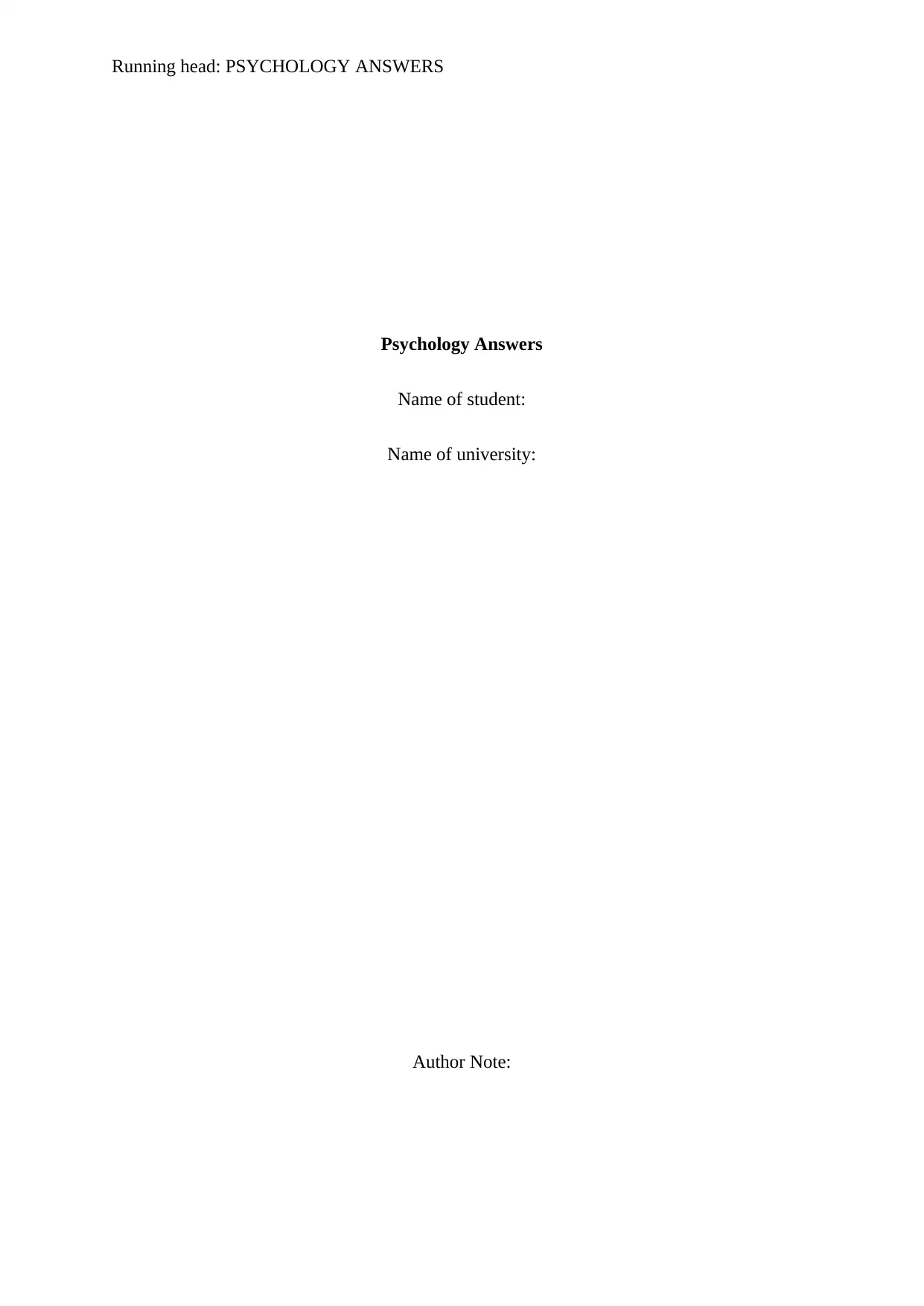
Running head: PSYCHOLOGY ANSWERS
Psychology Answers
Name of student:
Name of university:
Author Note:
Psychology Answers
Name of student:
Name of university:
Author Note:
Paraphrase This Document
Need a fresh take? Get an instant paraphrase of this document with our AI Paraphraser
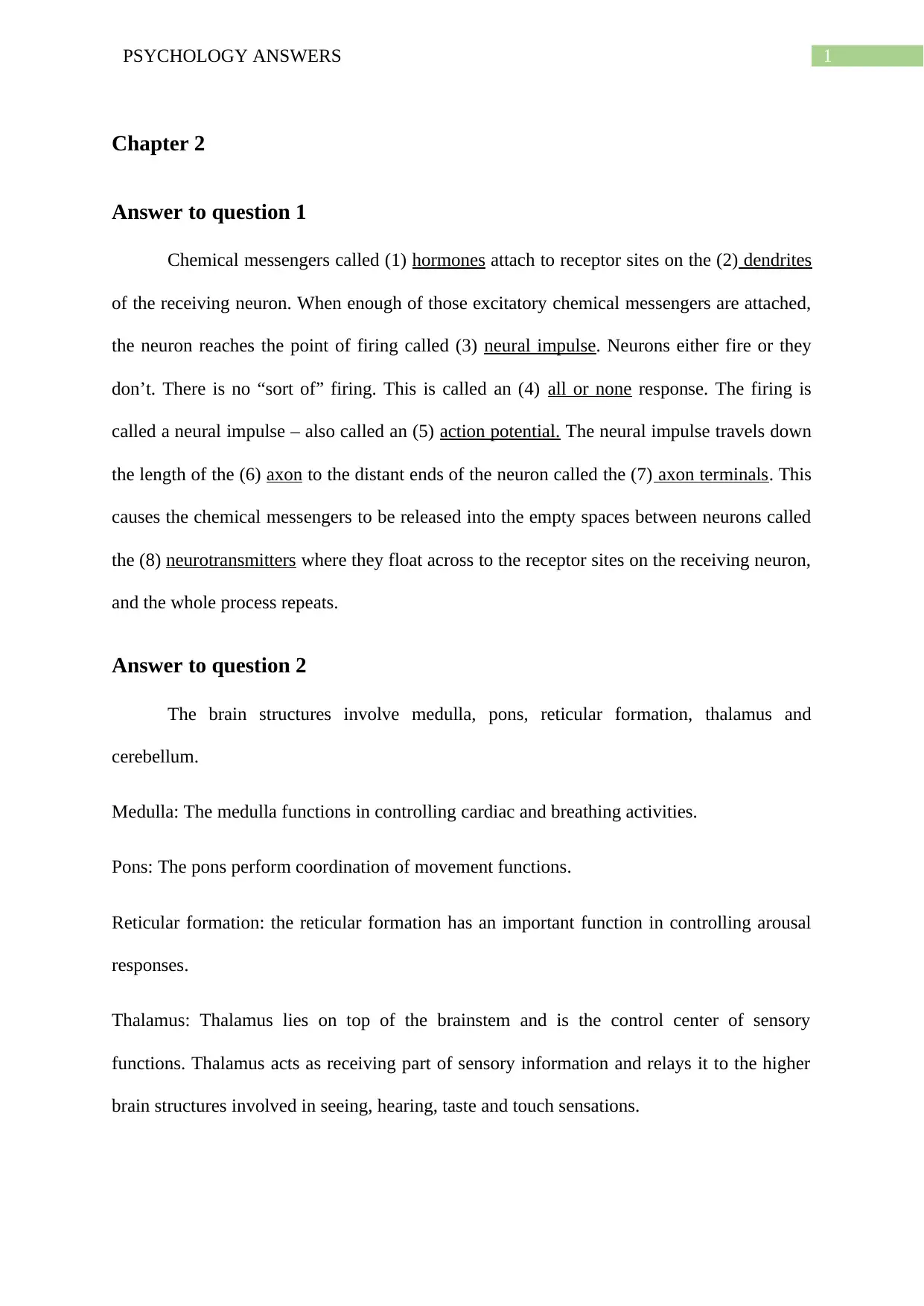
1PSYCHOLOGY ANSWERS
Chapter 2
Answer to question 1
Chemical messengers called (1) hormones attach to receptor sites on the (2) dendrites
of the receiving neuron. When enough of those excitatory chemical messengers are attached,
the neuron reaches the point of firing called (3) neural impulse. Neurons either fire or they
don’t. There is no “sort of” firing. This is called an (4) all or none response. The firing is
called a neural impulse – also called an (5) action potential. The neural impulse travels down
the length of the (6) axon to the distant ends of the neuron called the (7) axon terminals. This
causes the chemical messengers to be released into the empty spaces between neurons called
the (8) neurotransmitters where they float across to the receptor sites on the receiving neuron,
and the whole process repeats.
Answer to question 2
The brain structures involve medulla, pons, reticular formation, thalamus and
cerebellum.
Medulla: The medulla functions in controlling cardiac and breathing activities.
Pons: The pons perform coordination of movement functions.
Reticular formation: the reticular formation has an important function in controlling arousal
responses.
Thalamus: Thalamus lies on top of the brainstem and is the control center of sensory
functions. Thalamus acts as receiving part of sensory information and relays it to the higher
brain structures involved in seeing, hearing, taste and touch sensations.
Chapter 2
Answer to question 1
Chemical messengers called (1) hormones attach to receptor sites on the (2) dendrites
of the receiving neuron. When enough of those excitatory chemical messengers are attached,
the neuron reaches the point of firing called (3) neural impulse. Neurons either fire or they
don’t. There is no “sort of” firing. This is called an (4) all or none response. The firing is
called a neural impulse – also called an (5) action potential. The neural impulse travels down
the length of the (6) axon to the distant ends of the neuron called the (7) axon terminals. This
causes the chemical messengers to be released into the empty spaces between neurons called
the (8) neurotransmitters where they float across to the receptor sites on the receiving neuron,
and the whole process repeats.
Answer to question 2
The brain structures involve medulla, pons, reticular formation, thalamus and
cerebellum.
Medulla: The medulla functions in controlling cardiac and breathing activities.
Pons: The pons perform coordination of movement functions.
Reticular formation: the reticular formation has an important function in controlling arousal
responses.
Thalamus: Thalamus lies on top of the brainstem and is the control center of sensory
functions. Thalamus acts as receiving part of sensory information and relays it to the higher
brain structures involved in seeing, hearing, taste and touch sensations.
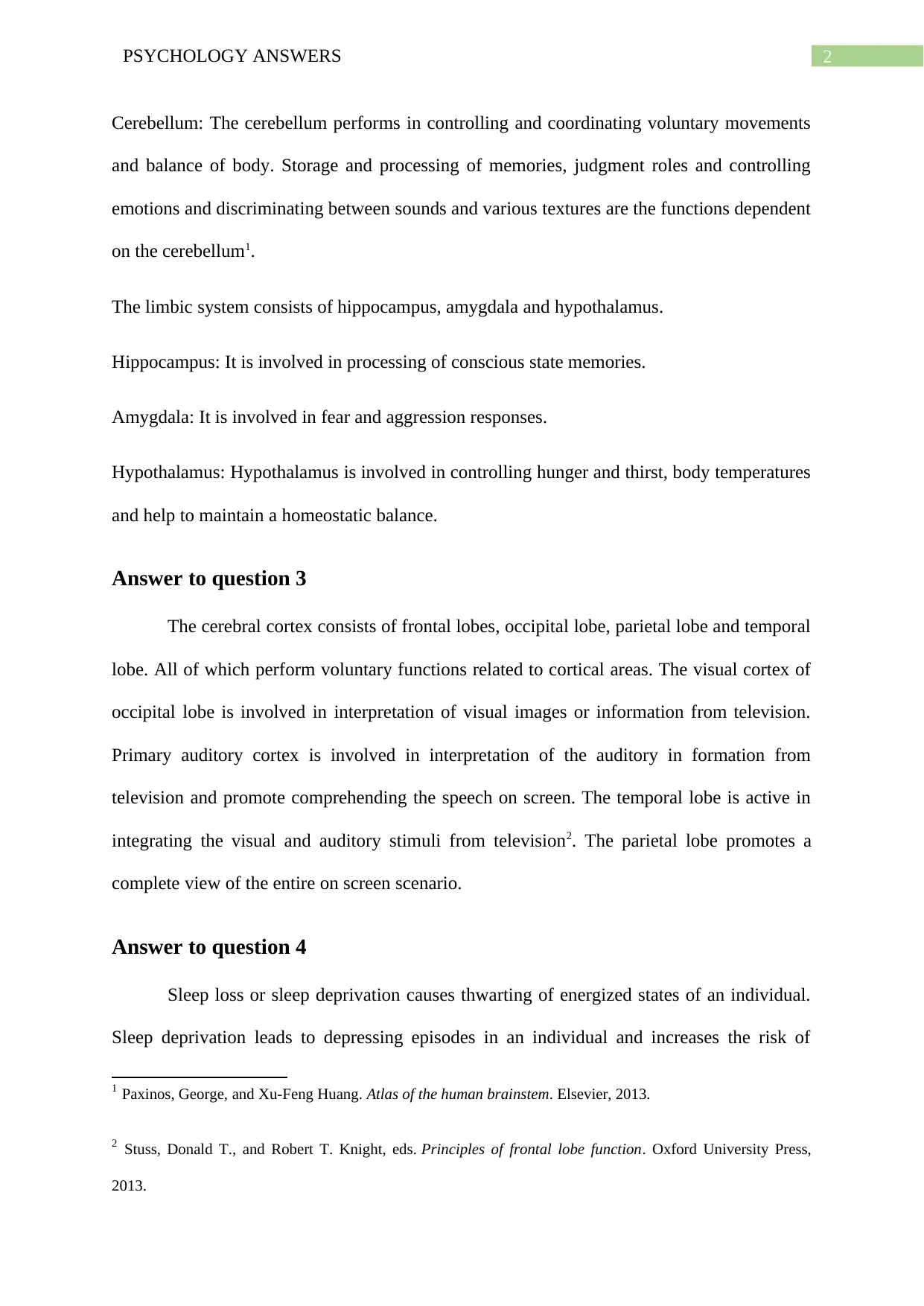
2PSYCHOLOGY ANSWERS
Cerebellum: The cerebellum performs in controlling and coordinating voluntary movements
and balance of body. Storage and processing of memories, judgment roles and controlling
emotions and discriminating between sounds and various textures are the functions dependent
on the cerebellum1.
The limbic system consists of hippocampus, amygdala and hypothalamus.
Hippocampus: It is involved in processing of conscious state memories.
Amygdala: It is involved in fear and aggression responses.
Hypothalamus: Hypothalamus is involved in controlling hunger and thirst, body temperatures
and help to maintain a homeostatic balance.
Answer to question 3
The cerebral cortex consists of frontal lobes, occipital lobe, parietal lobe and temporal
lobe. All of which perform voluntary functions related to cortical areas. The visual cortex of
occipital lobe is involved in interpretation of visual images or information from television.
Primary auditory cortex is involved in interpretation of the auditory in formation from
television and promote comprehending the speech on screen. The temporal lobe is active in
integrating the visual and auditory stimuli from television2. The parietal lobe promotes a
complete view of the entire on screen scenario.
Answer to question 4
Sleep loss or sleep deprivation causes thwarting of energized states of an individual.
Sleep deprivation leads to depressing episodes in an individual and increases the risk of
1 Paxinos, George, and Xu-Feng Huang. Atlas of the human brainstem. Elsevier, 2013.
2 Stuss, Donald T., and Robert T. Knight, eds. Principles of frontal lobe function. Oxford University Press,
2013.
Cerebellum: The cerebellum performs in controlling and coordinating voluntary movements
and balance of body. Storage and processing of memories, judgment roles and controlling
emotions and discriminating between sounds and various textures are the functions dependent
on the cerebellum1.
The limbic system consists of hippocampus, amygdala and hypothalamus.
Hippocampus: It is involved in processing of conscious state memories.
Amygdala: It is involved in fear and aggression responses.
Hypothalamus: Hypothalamus is involved in controlling hunger and thirst, body temperatures
and help to maintain a homeostatic balance.
Answer to question 3
The cerebral cortex consists of frontal lobes, occipital lobe, parietal lobe and temporal
lobe. All of which perform voluntary functions related to cortical areas. The visual cortex of
occipital lobe is involved in interpretation of visual images or information from television.
Primary auditory cortex is involved in interpretation of the auditory in formation from
television and promote comprehending the speech on screen. The temporal lobe is active in
integrating the visual and auditory stimuli from television2. The parietal lobe promotes a
complete view of the entire on screen scenario.
Answer to question 4
Sleep loss or sleep deprivation causes thwarting of energized states of an individual.
Sleep deprivation leads to depressing episodes in an individual and increases the risk of
1 Paxinos, George, and Xu-Feng Huang. Atlas of the human brainstem. Elsevier, 2013.
2 Stuss, Donald T., and Robert T. Knight, eds. Principles of frontal lobe function. Oxford University Press,
2013.
⊘ This is a preview!⊘
Do you want full access?
Subscribe today to unlock all pages.

Trusted by 1+ million students worldwide
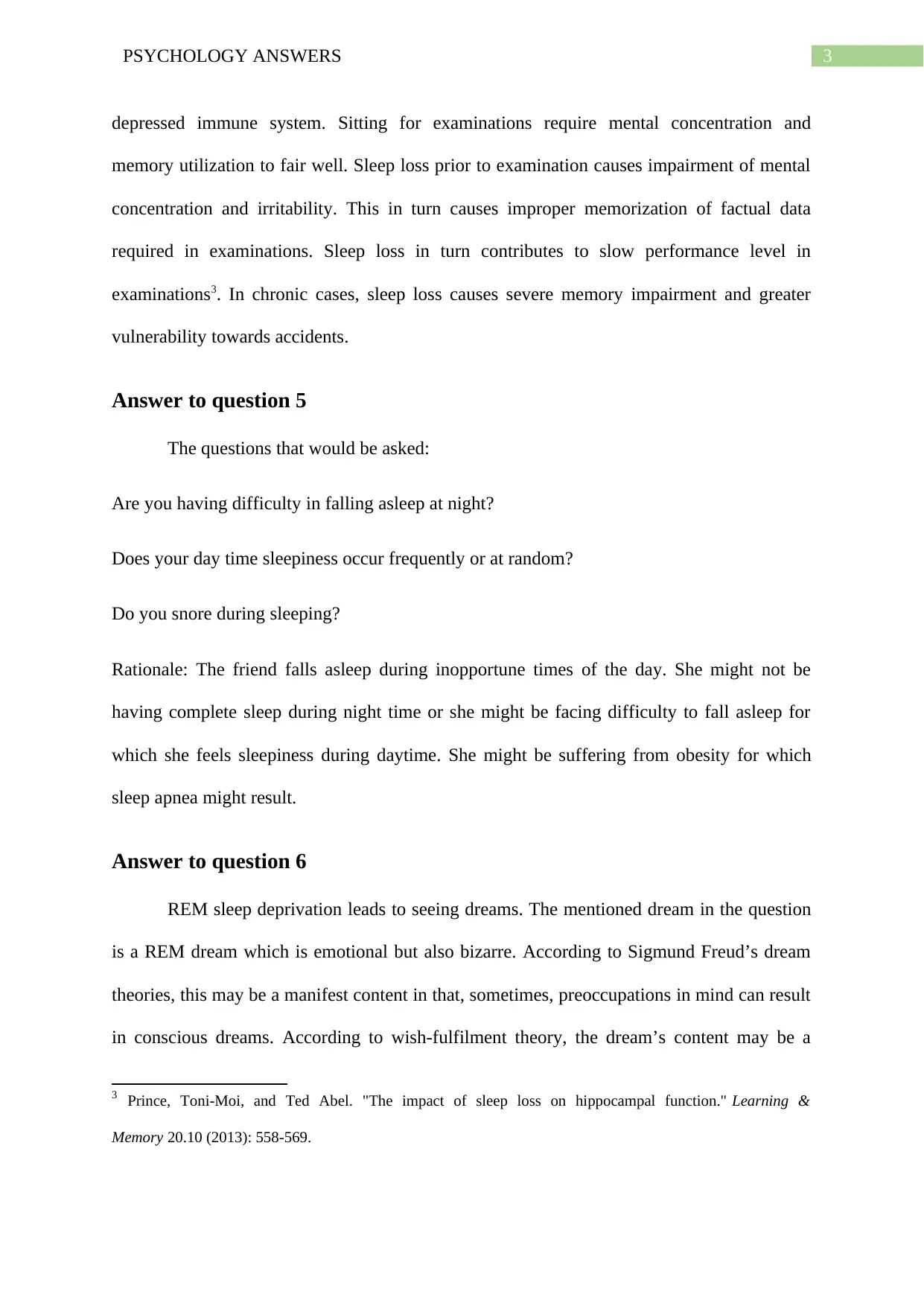
3PSYCHOLOGY ANSWERS
depressed immune system. Sitting for examinations require mental concentration and
memory utilization to fair well. Sleep loss prior to examination causes impairment of mental
concentration and irritability. This in turn causes improper memorization of factual data
required in examinations. Sleep loss in turn contributes to slow performance level in
examinations3. In chronic cases, sleep loss causes severe memory impairment and greater
vulnerability towards accidents.
Answer to question 5
The questions that would be asked:
Are you having difficulty in falling asleep at night?
Does your day time sleepiness occur frequently or at random?
Do you snore during sleeping?
Rationale: The friend falls asleep during inopportune times of the day. She might not be
having complete sleep during night time or she might be facing difficulty to fall asleep for
which she feels sleepiness during daytime. She might be suffering from obesity for which
sleep apnea might result.
Answer to question 6
REM sleep deprivation leads to seeing dreams. The mentioned dream in the question
is a REM dream which is emotional but also bizarre. According to Sigmund Freud’s dream
theories, this may be a manifest content in that, sometimes, preoccupations in mind can result
in conscious dreams. According to wish-fulfilment theory, the dream’s content may be a
3 Prince, Toni-Moi, and Ted Abel. "The impact of sleep loss on hippocampal function." Learning &
Memory 20.10 (2013): 558-569.
depressed immune system. Sitting for examinations require mental concentration and
memory utilization to fair well. Sleep loss prior to examination causes impairment of mental
concentration and irritability. This in turn causes improper memorization of factual data
required in examinations. Sleep loss in turn contributes to slow performance level in
examinations3. In chronic cases, sleep loss causes severe memory impairment and greater
vulnerability towards accidents.
Answer to question 5
The questions that would be asked:
Are you having difficulty in falling asleep at night?
Does your day time sleepiness occur frequently or at random?
Do you snore during sleeping?
Rationale: The friend falls asleep during inopportune times of the day. She might not be
having complete sleep during night time or she might be facing difficulty to fall asleep for
which she feels sleepiness during daytime. She might be suffering from obesity for which
sleep apnea might result.
Answer to question 6
REM sleep deprivation leads to seeing dreams. The mentioned dream in the question
is a REM dream which is emotional but also bizarre. According to Sigmund Freud’s dream
theories, this may be a manifest content in that, sometimes, preoccupations in mind can result
in conscious dreams. According to wish-fulfilment theory, the dream’s content may be a
3 Prince, Toni-Moi, and Ted Abel. "The impact of sleep loss on hippocampal function." Learning &
Memory 20.10 (2013): 558-569.
Paraphrase This Document
Need a fresh take? Get an instant paraphrase of this document with our AI Paraphraser
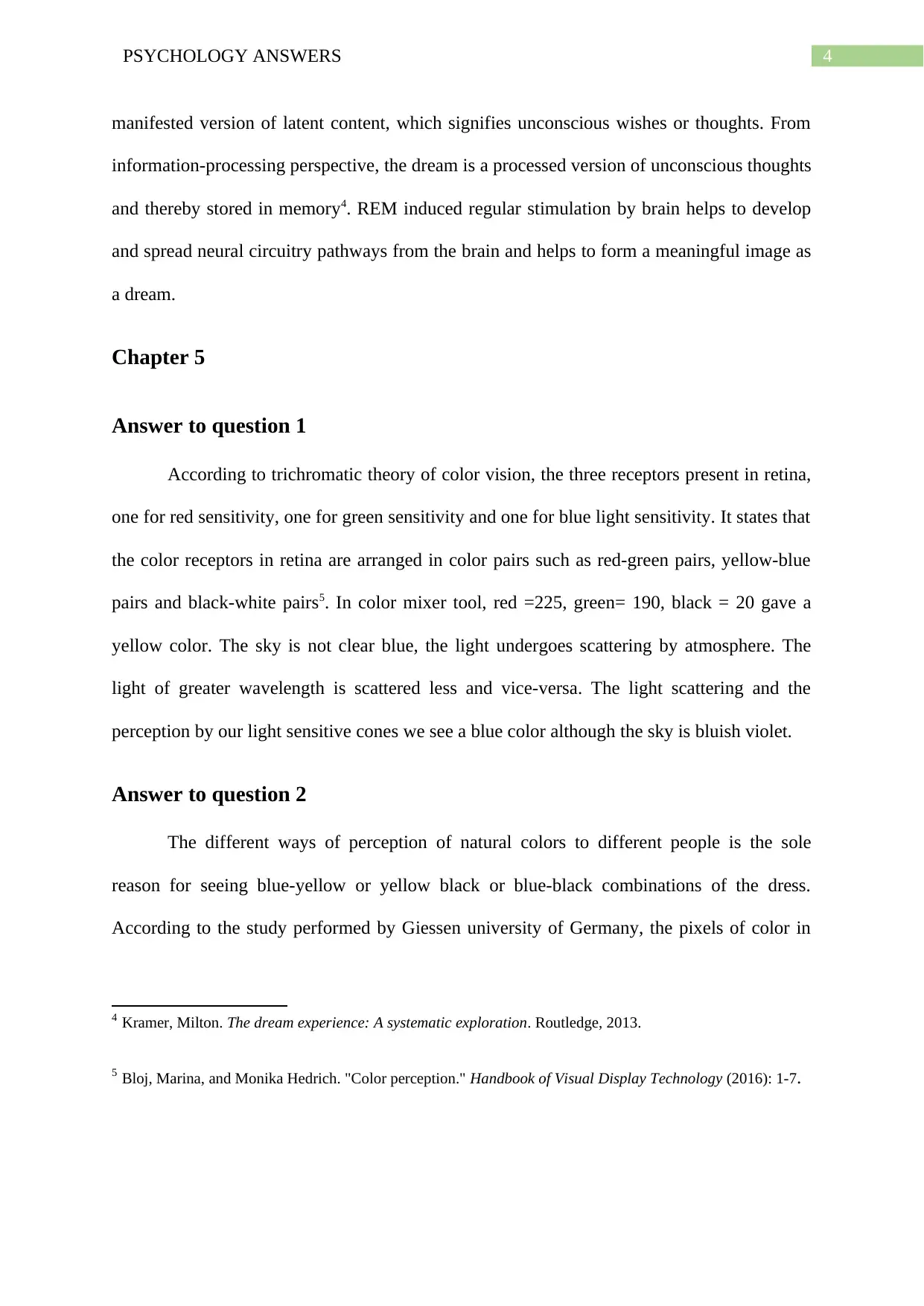
4PSYCHOLOGY ANSWERS
manifested version of latent content, which signifies unconscious wishes or thoughts. From
information-processing perspective, the dream is a processed version of unconscious thoughts
and thereby stored in memory4. REM induced regular stimulation by brain helps to develop
and spread neural circuitry pathways from the brain and helps to form a meaningful image as
a dream.
Chapter 5
Answer to question 1
According to trichromatic theory of color vision, the three receptors present in retina,
one for red sensitivity, one for green sensitivity and one for blue light sensitivity. It states that
the color receptors in retina are arranged in color pairs such as red-green pairs, yellow-blue
pairs and black-white pairs5. In color mixer tool, red =225, green= 190, black = 20 gave a
yellow color. The sky is not clear blue, the light undergoes scattering by atmosphere. The
light of greater wavelength is scattered less and vice-versa. The light scattering and the
perception by our light sensitive cones we see a blue color although the sky is bluish violet.
Answer to question 2
The different ways of perception of natural colors to different people is the sole
reason for seeing blue-yellow or yellow black or blue-black combinations of the dress.
According to the study performed by Giessen university of Germany, the pixels of color in
4 Kramer, Milton. The dream experience: A systematic exploration. Routledge, 2013.
5 Bloj, Marina, and Monika Hedrich. "Color perception." Handbook of Visual Display Technology (2016): 1-7.
manifested version of latent content, which signifies unconscious wishes or thoughts. From
information-processing perspective, the dream is a processed version of unconscious thoughts
and thereby stored in memory4. REM induced regular stimulation by brain helps to develop
and spread neural circuitry pathways from the brain and helps to form a meaningful image as
a dream.
Chapter 5
Answer to question 1
According to trichromatic theory of color vision, the three receptors present in retina,
one for red sensitivity, one for green sensitivity and one for blue light sensitivity. It states that
the color receptors in retina are arranged in color pairs such as red-green pairs, yellow-blue
pairs and black-white pairs5. In color mixer tool, red =225, green= 190, black = 20 gave a
yellow color. The sky is not clear blue, the light undergoes scattering by atmosphere. The
light of greater wavelength is scattered less and vice-versa. The light scattering and the
perception by our light sensitive cones we see a blue color although the sky is bluish violet.
Answer to question 2
The different ways of perception of natural colors to different people is the sole
reason for seeing blue-yellow or yellow black or blue-black combinations of the dress.
According to the study performed by Giessen university of Germany, the pixels of color in
4 Kramer, Milton. The dream experience: A systematic exploration. Routledge, 2013.
5 Bloj, Marina, and Monika Hedrich. "Color perception." Handbook of Visual Display Technology (2016): 1-7.
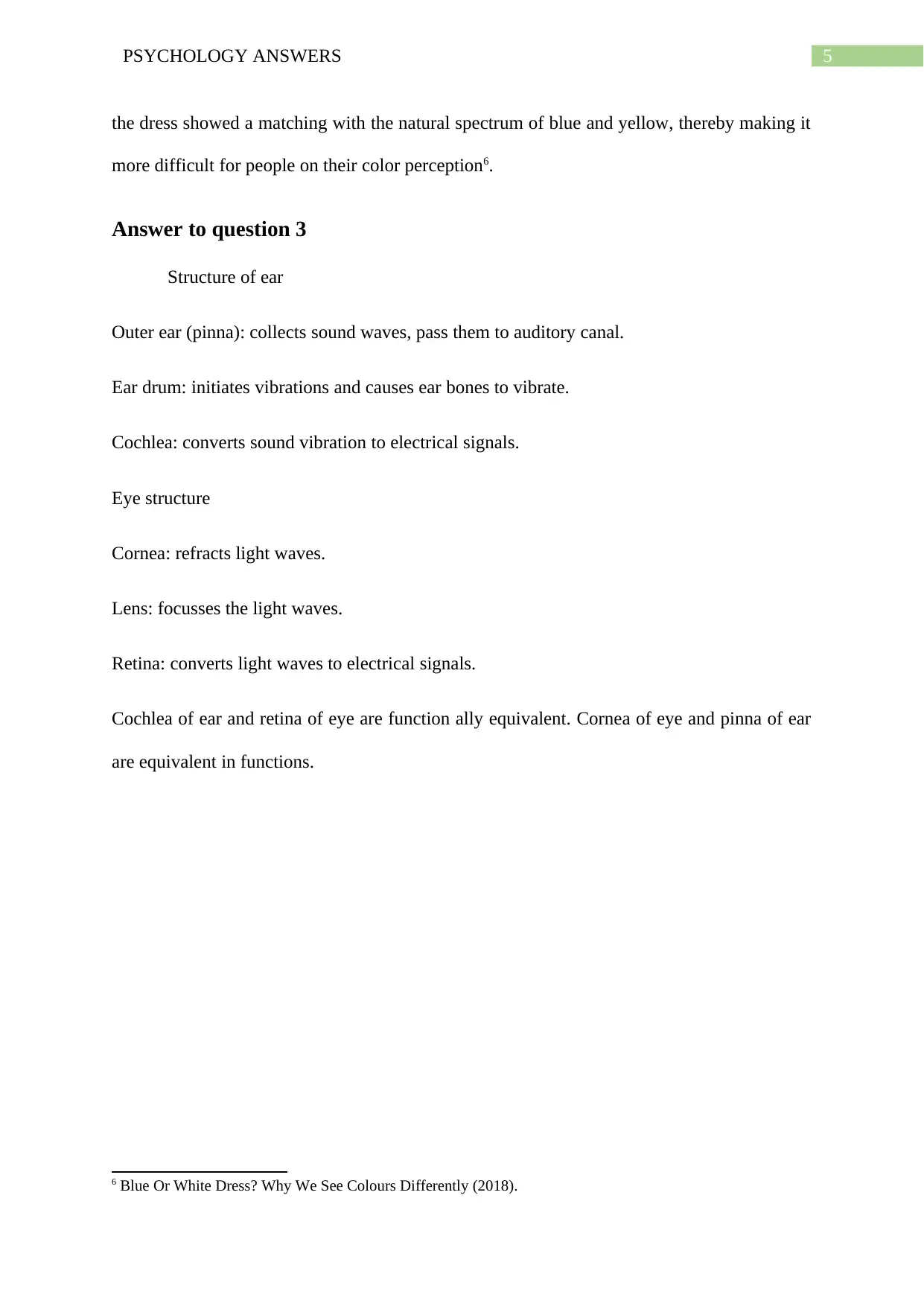
5PSYCHOLOGY ANSWERS
the dress showed a matching with the natural spectrum of blue and yellow, thereby making it
more difficult for people on their color perception6.
Answer to question 3
Structure of ear
Outer ear (pinna): collects sound waves, pass them to auditory canal.
Ear drum: initiates vibrations and causes ear bones to vibrate.
Cochlea: converts sound vibration to electrical signals.
Eye structure
Cornea: refracts light waves.
Lens: focusses the light waves.
Retina: converts light waves to electrical signals.
Cochlea of ear and retina of eye are function ally equivalent. Cornea of eye and pinna of ear
are equivalent in functions.
6 Blue Or White Dress? Why We See Colours Differently (2018).
the dress showed a matching with the natural spectrum of blue and yellow, thereby making it
more difficult for people on their color perception6.
Answer to question 3
Structure of ear
Outer ear (pinna): collects sound waves, pass them to auditory canal.
Ear drum: initiates vibrations and causes ear bones to vibrate.
Cochlea: converts sound vibration to electrical signals.
Eye structure
Cornea: refracts light waves.
Lens: focusses the light waves.
Retina: converts light waves to electrical signals.
Cochlea of ear and retina of eye are function ally equivalent. Cornea of eye and pinna of ear
are equivalent in functions.
6 Blue Or White Dress? Why We See Colours Differently (2018).
⊘ This is a preview!⊘
Do you want full access?
Subscribe today to unlock all pages.

Trusted by 1+ million students worldwide
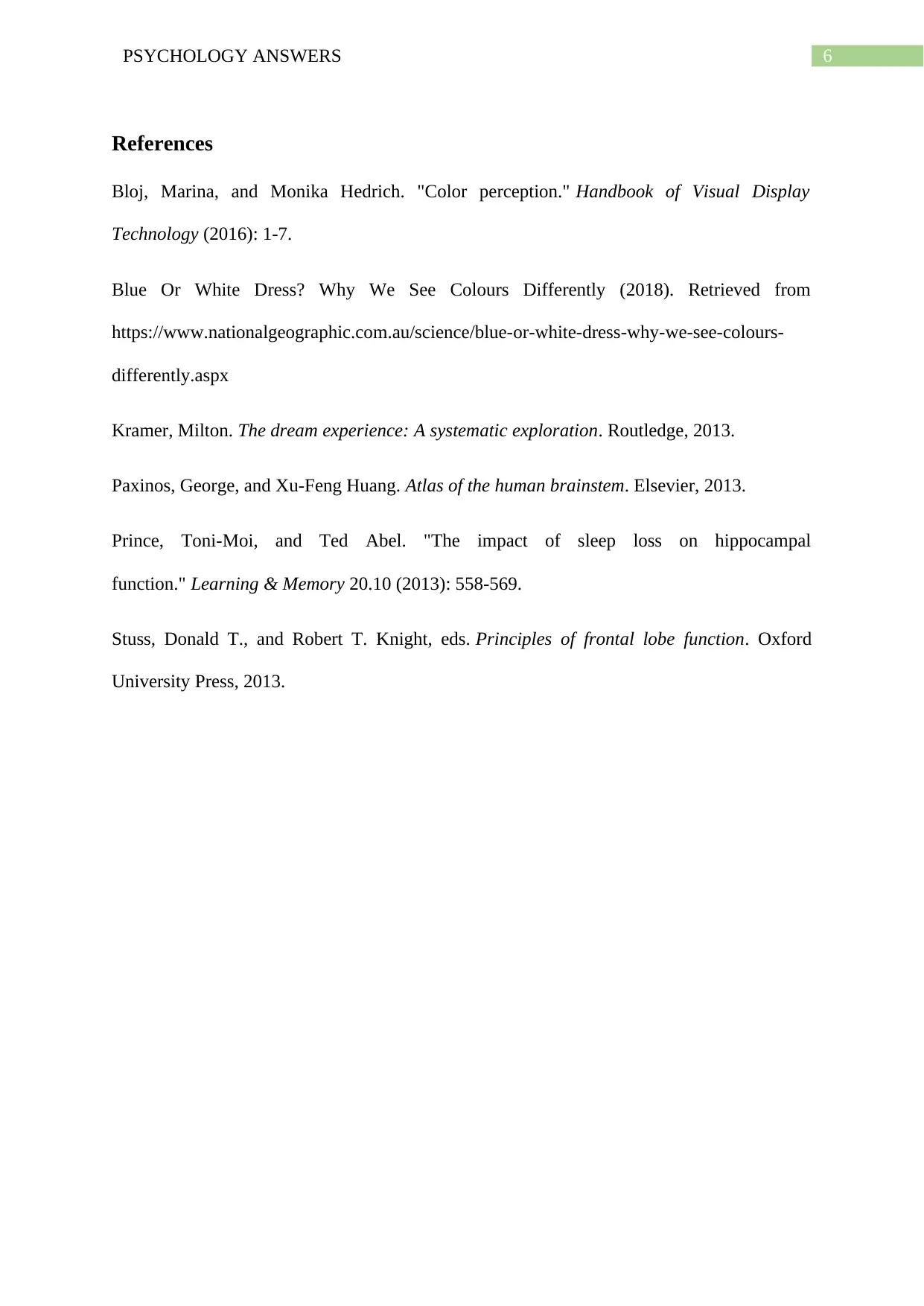
6PSYCHOLOGY ANSWERS
References
Bloj, Marina, and Monika Hedrich. "Color perception." Handbook of Visual Display
Technology (2016): 1-7.
Blue Or White Dress? Why We See Colours Differently (2018). Retrieved from
https://www.nationalgeographic.com.au/science/blue-or-white-dress-why-we-see-colours-
differently.aspx
Kramer, Milton. The dream experience: A systematic exploration. Routledge, 2013.
Paxinos, George, and Xu-Feng Huang. Atlas of the human brainstem. Elsevier, 2013.
Prince, Toni-Moi, and Ted Abel. "The impact of sleep loss on hippocampal
function." Learning & Memory 20.10 (2013): 558-569.
Stuss, Donald T., and Robert T. Knight, eds. Principles of frontal lobe function. Oxford
University Press, 2013.
References
Bloj, Marina, and Monika Hedrich. "Color perception." Handbook of Visual Display
Technology (2016): 1-7.
Blue Or White Dress? Why We See Colours Differently (2018). Retrieved from
https://www.nationalgeographic.com.au/science/blue-or-white-dress-why-we-see-colours-
differently.aspx
Kramer, Milton. The dream experience: A systematic exploration. Routledge, 2013.
Paxinos, George, and Xu-Feng Huang. Atlas of the human brainstem. Elsevier, 2013.
Prince, Toni-Moi, and Ted Abel. "The impact of sleep loss on hippocampal
function." Learning & Memory 20.10 (2013): 558-569.
Stuss, Donald T., and Robert T. Knight, eds. Principles of frontal lobe function. Oxford
University Press, 2013.
1 out of 7
Your All-in-One AI-Powered Toolkit for Academic Success.
+13062052269
info@desklib.com
Available 24*7 on WhatsApp / Email
![[object Object]](/_next/static/media/star-bottom.7253800d.svg)
Unlock your academic potential
Copyright © 2020–2025 A2Z Services. All Rights Reserved. Developed and managed by ZUCOL.


